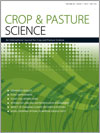Arbuscular mycorrhizal fungi (AMF) play an important role in protecting plant growth against such stresses as phytotoxic aluminium (Al) in soil. To understand some of the AMF interactions that relate to amelioration of Al phytotoxicity and phosphorus (P)-uptake efficiency in barley (Hordeum vulgare L.), this study examined the effect of soil Al levels and mycorrhizal symbiosis on plant response, including root colonisation, AMF propagules and glomalin production. A greenhouse experiment was conducted using two native barley cultivars, Sebastián and Aurora, grown in an acidic soil at two Al-saturation levels (80% Al-sat, unlimed soil; 7% Al-sat, limed soil) with and without AMF propagules. Root dry weight, total and colonised root lengths, and root P and Al contents were determined at 60 and 150 days after sowing. AMF spore density, total hyphal length, glomalin-related soil protein (GRSP) and Al bound to GRSP (Al-GRSP) were analysed at final harvest. AM root colonisation was not inhibited in limed soil, mycorrhizal propagule numbers increased at high Al levels, and Al-GRSP ranged from 5.6% to 8.3% of the total GRSP weight. These values also increased in unlimed soil, particularly those associated with cv. Aurora. Root Al concentration correlated inversely with AMF spores (r = –0.85, P < 0.001) and Al-GRSP (r = –0.72, P < 0.01), but only in plants growing in limed soil. Conversely, the AMF treatments in which Al was present showed a greater relationship between total root length and both root Al (r = –0.72, P < 0.01) and root P (r = 0.66, P < 0.01) concentrations. Sebastián showed a greater response to lime, whereas Aurora responded better to mycorrhizal presence. The relative growth rate of roots, P uptake efficiency and mycorrhizal parameters such as root colonisation, spores, hyphae and GRSP showed Aurora to be more Al-tolerant than Sebastián. In conclusion, the greater rate of increase of AM propagules, GRSP and Al-GRSP associated with cv. Aurora supports the hypothesis that AMF play an important role in the Al-tolerance capacity and P-uptake efficiency of H. vulgare growing in soils with high Al levels.
How to translate text using browser tools
24 June 2015
Role of arbuscular mycorrhizal symbiosis in phosphorus-uptake efficiency and aluminium tolerance in barley growing in acid soils
Alex Seguel,
José Miguel Barea,
Pablo Cornejo,
Fernando Borie
ACCESS THE FULL ARTICLE

Crop and Pasture Science
Vol. 66 • No. 7
June 2015
Vol. 66 • No. 7
June 2015
Al-tolerant barley cultivars
arbuscular mycorrhizae
Glomalin-related soil protein
liming
P-uptake efficiency




